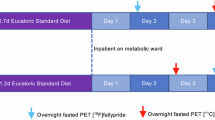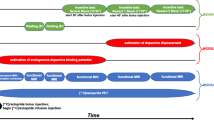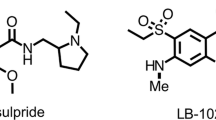Abstract
(−)-OSU6162 is a dopamine stabilizer that can counteract both hyperdopaminergic and hypodopaminergic states. In this study, D2/D3 receptor occupancy of (−)-OSU6162 in the human brain was investigated using positron emission tomography (PET). Twelve male healthy volunteers underwent [11C]raclopride PET scanning before and 1 h after a single oral dose of (−)-OSU6162 (15–90 mg). Blood samples for determination of (−)-OSU6162 and prolactin plasma levels were collected at Tmax. Parametric images of [11C]raclopride binding potential relative to nondisplaceable tissue (cerebellar grey matter) uptake (BPND) at baseline and after (−)-OSU6162 administration were generated using the simplified reference tissue model. MRI-based regions of interest were defined for the striatum, composed of caudate nucleus and putamen, and projected onto the co-registered parametric [11C]raclopride BPND image. Furthermore, three striatal subregions, ie, anterior dorsal caudate, anterior dorsal putamen, and ventral striatum, were defined manually and additionally analyzed. Plasma concentrations of (−)-OSU6162, ranging from 0.01 to 0.9 μM, showed a linear relationship with prolactin levels, reflecting blockade of pituitary D2 receptors. A concentration-dependent increase in striatal D2/D3 receptor occupancy was observed, reaching a value of about 20% at an (−)-OSU6162 plasma level of 0.2 μM, and which for higher concentrations leveled off to a maximal occupancy of about 40%. Findings were similar in the striatal subregions. The present data corroborate the notion that (−)-OSU6162 binds preferentially to a subpopulation of D2/D3 receptors, possibly predominantly extrasynaptic, and this may form the basis for the dopamine-stabilizing properties of (−)-OSU6162.
Similar content being viewed by others
Log in or create a free account to read this content
Gain free access to this article, as well as selected content from this journal and more on nature.com
or
References
Alakurtti K, Johansson JJ, Tuokkola T, Nägren K, Rinne JO (2013). Rostrocaudal gradients of dopamine D2/3 receptor binding in striatal subregions measured with [11C]raclopride and high-resolution positron emission tomography. Neuroimage 82: 252–259.
Bressan RA, Erlandsson K, Spencer EP, Ell PJ, Pilowsky LS (2004). Prolactinemia is uncoupled from central D2/D3 dopamine receptor occupancy in amisulpride treated patients. Psychopharmacology (Berl) 175: 367–373.
Brix G, Zaers J, Adam LE, Bellemann ME, Ostertag H, Trojan H et al (1997). Performance evaluation of a whole-body PET scanner using the NEMA protocol. National Electrical Manufacturers Association. J Nucl Med 38: 1614–1623.
Burstein ES, Carlsson ML, Owens M, Ma JN, Schiffer HH, Carlsson A et al (2011). II. In vitro evidence that (−)-OSU6162 and (+)-OSU6162 produce their behavioral effects through 5-HT2A serotonin and D2 dopamine receptors. J Neural Transm 118: 1523–1533.
Carlsson A, Carlsson ML (2006). A dopaminergic deficit hypothesis of schizophrenia: the path to discovery. Dialogues Clin Neurosci 8: 137–142.
Carlsson ML, Burstein ES, Kloberg A, Hansson S, Schedwin A, Nilsson M et al (2011). I. In vivo evidence for partial agonist effects of (−)-OSU6162 and (+)-OSU6162 on 5-HT2A serotonin receptors. J Neural Transm 118: 1511–1522.
Carlsson ML, Carlsson A, Nilsson M (2004). Schizophrenia: from dopamine to glutamate and back. Curr Med Chem 11: 267–277.
Dyhring T, Nielsen EO, Sonesson C, Pettersson F, Karlsson J, Svensson P et al (2010). The dopaminergic stabilizers pridopidine (ACR16) and (−)-OSU6162 display dopamine D(2) receptor antagonism and fast receptor dissociation properties. Eur J Pharmacol 628: 19–26.
Ehrin E, Gawell L, Hogberg T, de Paulis T, Strom P (1987). Synthesis of [methoxy-3H]- and [methoxy-11C]-labelled raclopride. Specific dopamine-D2 receptor ligands. J Labell Compounds Radiopharm 24: 931–940.
Ekesbo A, Torstenson R, Hartvig P, Carlsson A, Sonesson C, Waters N et al (1999). Effects of the substituted (S)-3-phenylpiperidine (−)-OSU6162 on PET measurements of [11C]SCH23390 and [11C]raclopride binding in primate brains. Neuropharmacology 38: 331–338.
Farde L, Nordstrom AL, Wiesel FA, Pauli S, Halldin C, Sedvall G (1992). Positron emission tomographic analysis of central D1 and D2 dopamine receptor occupancy in patients treated with classical neuroleptics and clozapine. Relation to extrapyramidal side effects. Arch Gen Psychiatry 49: 538–544.
Gefvert O, Lundberg T, Wieselgren IM, Bergstrom M, Langstrom B, Wiesel F et al (2001). D(2) and 5HT(2A) receptor occupancy of different doses of quetiapine in schizophrenia: a PET study. Eur Neuropsychopharmacol 11: 105–110.
Groenewegen HJ (2007). The ventral striatum as an interface between the limbic and motor systems. CNS Spectr 12: 887–892.
Han Y, Moreira IS, Urizar E, Weinstein H, Javitch JA (2009). Allosteric communication between protomers of dopamine class A GPCR dimers modulates activation. Nat Chem Biol 5: 688–695.
Innis RB, Cunningham VJ, Delforge J, Fujita M, Gjedde A, Gunn RN et al (2007). Consensus nomenclature for in vivo imaging of reversibly binding radioligands. J Cereb Blood Flow Metab 27: 1533–1539.
Johansson B, Carlsson A, Carlsson ML, Karlsson M, Nilsson MKL, Nordquist-Brandt E et al (2012). Placebo-controlled cross-over study of the monoaminergic stabiliser (−)-OSU6162 in mental fatigue following stroke or traumatic brain injury. Acta Neuropsychiatr 24: 266–274.
Kapur S, Zipursky R, Jones C, Shammi CS, Remington G, Seeman P (2000). A positron emission tomography study of quetiapine in schizophrenia: a preliminary finding of an antipsychotic effect with only transiently high dopamine D2 receptor occupancy. Arch Gen Psychiatry 57: 553–559.
Kara E, Lin H, Strange PG (2010a). Co-operativity in agonist binding at the D2 dopamine receptor: evidence from agonist dissociation kinetics. J Neurochem 112: 1442–1453.
Kara E, Lin H, Svensson K, Johansson AM, Strange PG (2010b). Analysis of the actions of the novel dopamine receptor-directed compounds (S)-OSU6162 and ACR16 at the D2 dopamine receptor. Br J Pharmacol 161: 1343–1350.
Kloberg A, Constantinescu R, Nilsson MKL, Carlsson ML, Carlsson A, Wahlström J et al (2014). Tolerability and efficacy of the monoaminergic stabilizer (−)-OSU6162 (PNU-96391A) in Huntington's disease: a double-blind cross-over study. Acta Neuropsychiatrica (doi:10.1017/neu.2014.16).
Lahti RA, Tamminga CA, Carlsson A (2007). Stimulating and inhibitory effects of the dopamine ‘stabilizer’ (−)-OSU6162 on dopamine D2 receptor function in vitro. J Neural Transm 114: 1143–1146.
Langlois X, Megens A, Lavreysen H, Atack J, Cik M, te RP et al (2012). Pharmacology of JNJ-37822681, a specific and fast-dissociating D2 antagonist for the treatment of schizophrenia. J Pharmacol Exp Ther 342: 91–105.
Leysen JE (2002). Atypical antipsychotics. In: Di Chiara G, eds. Handbook of Experimental Pharmacology Vol 154/II. Springer Verlag: Berlin, Heidelberg, Germany. pp 473–490.
Maes F, Collignon A, Vandermeulen D, Marchal G, Suetens P (1997). Multimodality image registration by maximization of mutual information. IEEE Trans Med Imaging 16: 187–198.
Martinez D, Slifstein M, Broft A, Mawlawi O, Hwang DR, Huang Y et al (2003). Imaging human mesolimbic dopamine transmission with positron emission tomography. Part II: amphetamine-induced dopamine release in the functional subdivisions of the striatum. J Cereb Blood Flow Metab. 23: 285–300.
Mawlawi O, Martinez D, Slifstein M, Broft A, Chatterjee R, Hwang DR et al (2001). Imaging human mesolimbic dopamine transmission with positron emission tomography: I. Accuracy and precision of D(2) receptor parameter measurements in ventral striatum. J Cereb Blood Flow Metab 21: 1034–1057.
Natesan S, Svensson KA, Reckless GE, Nobrega JN, Barlow KB, Johansson AM et al (2006). The dopamine stabilizers (S)-(−)-(3-methanesulfonyl-phenyl)-1-propyl-piperidine [(−)-OSU6162] and 4-(3-methanesulfonylphenyl)-1-propyl-piperidine (ACR16) show high in vivo D2 receptor occupancy, antipsychotic-like efficacy, and low potential for motor side effects in the rat. J Pharmacol Exp Ther 318: 810–818.
Pani L, Pira L, Marchese G (2007). Antipsychotic efficacy: relationship to optimal D2-receptor occupancy. Eur Psychiatry 22: 267–275.
Rodriguez CA, Azie NE, Adams G, Donaldson K, Francom SF, Staton BA et al (2004). Single oral dose safety, tolerability, and pharmacokinetics of PNU-96391 in healthy volunteers. J Clin Pharmacol 44: 276–283.
Rung JP, Rung E, Helgeson L, Johansson AM, Svensson K, Carlsson A et al (2008). Effects of (−)-OSU6162 and ACR16 on motor activity in rats, indicating a unique mechanism of dopaminergic stabilization. J Neural Transm 115: 899–908.
Rung JP, Rung E, Johansson AM, Svensson K, Carlsson A, Carlsson ML (2011). Effects of the dopamine stabilizers (S)-(−)-OSU6162 and ACR16 on prolactin secretion in drug-naive and monoamine-depleted rats. Naunyn Schmiedebergs Arch Pharmacol 384: 39–45.
Sahlholm K, Arhem P, Fuxe K, Marcellino D (2013). The dopamine stabilizers ACR16 and (−)-OSU6162 display nanomolar affinities at the sigma-1 receptor. Mol Psychiatry 18: 12–14.
Seeman P, Tallerico T (1999). Rapid release of antipsychotic drugs from dopamine D2 receptors: an explanation for low receptor occupancy and early clinical relapse upon withdrawal of clozapine or quetiapine. Am J Psychiatry 156: 876–884.
Sonesson C, Lin CH, Hansson L, Waters N, Svensson K, Carlsson A et al (1994). Substituted (S)-phenylpiperidines and rigid congeners as preferential dopamine autoreceptor antagonists: synthesis and structure-activity relationships. J Med Chem 37: 2735–2753.
Sugawara N, Yasui-Furukori N, Fujii A, Saito M, Sato Y, Nakagami T et al (2011). No association between bone mass and prolactin levels among patients with schizophrenia. Hum Psychopharmacol 26: 596–601.
Svarer C, Madsen K, Hasselbalch SG, Pinborg LH, Haugbol S, Frokjaer VG et al (2005). MR-based automatic delineation of volumes of interest in human brain PET images using probability maps. Neuroimage 24: 969–979.
Svensson KA, Falcone JF, Johansson AM, Perry KW, Fell MA (2009). The actions of the dopamine stabilizer ACR16, but not (−)-OSU6162, in behavioral and neurochemical assays are not dependent on the presence of functional D2 receptors. Society for Neuroscience (Washington, DC), Annual Meeting; 9–13 Nov 2009; San Diego, CA, USA.
Te Beek ET, de BP, Moerland M, Schmidt ME, Hoetjes NJ, Windhorst AD et al (2012). In vivo quantification of striatal dopamine D2 receptor occupancy by JNJ-37822681 using [11C]raclopride and positron emission tomography. J Psychopharmacol 26: 1128–1135.
Tedroff J, Ekesbo A, Sonesson C, Waters N, Carlsson A (1999). Long-lasting improvement following (−)-OSU6162 in a patient with Huntington's disease. Neurology 53: 1605–1606.
Voorn P, Vanderschuren LJMJ, Groenewegen HJ, Robbins TW, Pennartz CMA (2004). Putting a spin on the dorsal-ventral divide of the striatum. Trends Neurosci 27: 468–474.
Wienkers LC, Wynalda MA (2002). Multiple cytochrome P450 enzymes responsible for the oxidative metabolism of the substituted (S)-3-phenylpiperidine, (S,S)-3-[3-(methylsulfonyl)phenyl]-1-propylpiperidine hydrochloride, in human liver microsomes. Drug Metab Dispos. 30: 1372–1377.
Wu Y, Carson RE (2002). Noise reduction in the simplified reference tissue model for neuroreceptor functional imaging. J Cereb Blood Flow Metab 22: 1440–1452.
Yamazaki S, Toth LN, Kimoto E, Bower J, Skaptason J, Romero D et al (2009). Application of stable isotope methodology in the evaluation of the pharmacokinetics of (S,S)-3-[3-(methylsulfonyl)phenyl]-1-propylpiperidine hydrochloride in rats. Drug Metab Dispos 37: 937–945.
Yokoi F, Gründer G, Biziere K, Stephane M, Dogan AS, Dannals RF et al (2002). Dopamine D2 and D3 receptor occupancy in normal humans treated with the antipsychotic drug aripiprazole (OPC 14597): a study using positron emission tomography and [11C]raclopride. Neuropsychopharmacology 27: 248–259.
Author information
Authors and Affiliations
Corresponding author
Rights and permissions
About this article
Cite this article
Tolboom, N., Berendse, H., Leysen, J. et al. The Dopamine Stabilizer (−)-OSU6162 Occupies a Subpopulation of Striatal Dopamine D2/D3 Receptors: An [11C]Raclopride PET Study in Healthy Human Subjects. Neuropsychopharmacol 40, 472–479 (2015). https://doi.org/10.1038/npp.2014.195
Received:
Revised:
Accepted:
Published:
Issue date:
DOI: https://doi.org/10.1038/npp.2014.195
This article is cited by
-
The monoamine stabilizer OSU6162 has anxiolytic-like properties and reduces voluntary alcohol intake in a genetic rat model of depression
Scientific Reports (2021)
-
The Effects of the Monoamine Stabilizer (−)-OSU6162 on Binge-Like Eating and Cue-Controlled Food-Seeking Behavior in Rats
Neuropsychopharmacology (2018)
-
A comprehensive map of molecular drug targets
Nature Reviews Drug Discovery (2017)
-
The effects of the dopamine stabilizer (−)-OSU6162 on aggressive and sexual behavior in rodents
Translational Psychiatry (2016)
-
Pridopidine selectively occupies sigma-1 rather than dopamine D2 receptors at behaviorally active doses
Psychopharmacology (2015)



